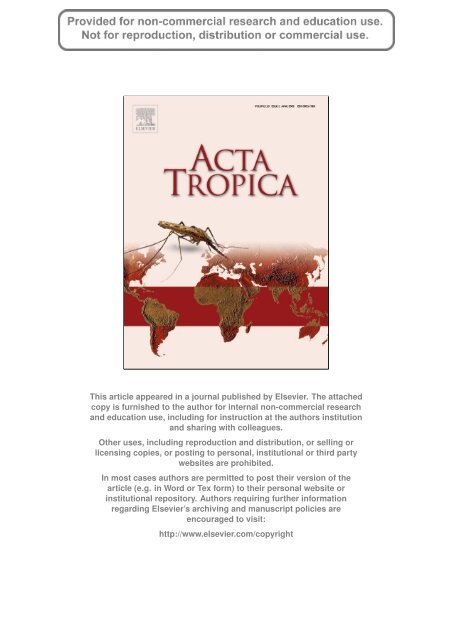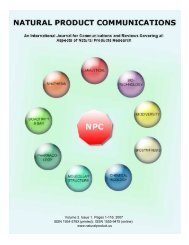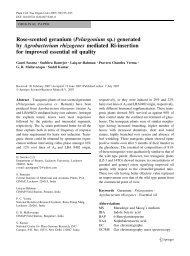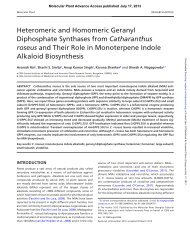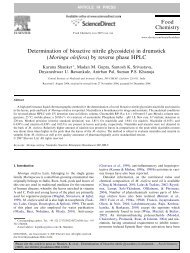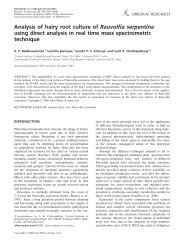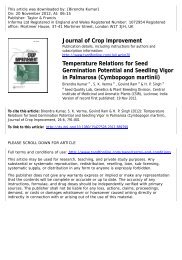Identification of genetic markers in Sodium Antimony ... - CIMAP Staff
Identification of genetic markers in Sodium Antimony ... - CIMAP Staff
Identification of genetic markers in Sodium Antimony ... - CIMAP Staff
Create successful ePaper yourself
Turn your PDF publications into a flip-book with our unique Google optimized e-Paper software.
This article appeared <strong>in</strong> a journal published by Elsevier. The attachedcopy is furnished to the author for <strong>in</strong>ternal non-commercial researchand education use, <strong>in</strong>clud<strong>in</strong>g for <strong>in</strong>struction at the authors <strong>in</strong>stitutionand shar<strong>in</strong>g with colleagues.Other uses, <strong>in</strong>clud<strong>in</strong>g reproduction and distribution, or sell<strong>in</strong>g orlicens<strong>in</strong>g copies, or post<strong>in</strong>g to personal, <strong>in</strong>stitutional or third partywebsites are prohibited.In most cases authors are permitted to post their version <strong>of</strong> thearticle (e.g. <strong>in</strong> Word or Tex form) to their personal website or<strong>in</strong>stitutional repository. Authors requir<strong>in</strong>g further <strong>in</strong>formationregard<strong>in</strong>g Elsevier’s archiv<strong>in</strong>g and manuscript policies areencouraged to visit:http://www.elsevier.com/copyright
Author's personal copyA. Kumar et al. / Acta Tropica 110 (2009) 80–85 83Table 3Group specific AFLP <strong>markers</strong> (size <strong>in</strong> bp) <strong>of</strong> SAG sensitive and resistance stra<strong>in</strong> <strong>of</strong> L.donovani.Primer comb<strong>in</strong>ationsSAG sensitivestra<strong>in</strong>s specificbands (bp)SAG resistantstra<strong>in</strong>s specificbands (bp)Fig. 2. Pr<strong>in</strong>cipal component plot based on the AFLP data <strong>of</strong> six cl<strong>in</strong>ical isolates <strong>of</strong> L.donovani (a–Dd8,b–2001,c–2039, d–2041,e–2087, f – 2093).and MseI-CAG/EcoRI-AGC were found to be important for detection<strong>in</strong> respect <strong>of</strong> SAG resistant isolates, and MseI-CAA/EcoRI-AGG,MseI-CTC/EcoRI-ACA, MseI-CTA/EcoRI-AGC, and MseI-CTG/EcoRI-AGC for SAG sensitive ones.4. DiscussionIn our earlier study, us<strong>in</strong>g six cl<strong>in</strong>ical isolates <strong>of</strong> L. donovani, wehave demonstrated the differential expression and <strong>in</strong>tensity <strong>of</strong> PPGMseI-CAA/ECoRI-ACA 110, 240, 262, 390MseI-CAA/ECoRI-AGC 143, 215 273, 346, 352MseI-CAC/ECoRI-ACG 320MseI-CAA/EcoRI-ACT 269, 276, 346MseI-CAA/EcoRI-AGG 160, 240MseI-CAC/EcoRI-ACT 277MseI-CAC/EcoRI-AAG 174, 264, 299MseI-CAT/EcoRI-ACA 202 332, 337, 340MseI-CAT/EcoRI-AGC 179, 218MseI-CTC/EcoRI-ACA 117MseI-CAG/EcoRI-AGC 274MseI-CTA/EcoRI-ACA 250 281, 314, 366MseI-CTA/EcoRI-ACG 135, 316 198MseI-CTA/EcoRI-AGC 113MseI-CTG/EcoRI-ACA 161 202MseI-CTG/EcoRI-ACG 165 212MseI-CTG/EcoRI-AGC 378MseI-CTT/EcoRI-ACT 174 206by FACS and Western blott<strong>in</strong>g which was higher <strong>in</strong> SSG resistantisolates (Samant et al., 2007). The observation <strong>of</strong> differential expression<strong>of</strong> PPG <strong>in</strong> drug-resistant and sensitive stra<strong>in</strong>s gave an <strong>in</strong>dication<strong>of</strong> genomic variations that are responsible for drug resistance. Thedifficulty <strong>in</strong>volved <strong>in</strong> the understand<strong>in</strong>g related to SAG resistance<strong>of</strong> Leishmania, highlighted the need for a DNA marker system foreasy detection and diagnosis aga<strong>in</strong>st leishmaniasis. Exploration <strong>of</strong>these <strong>genetic</strong> variations could provide a way for marker identi-Table 2Unique molecular marker bands (size <strong>in</strong> bp) specific for each SAG sensitive and resistance stra<strong>in</strong>s <strong>of</strong> L. donovani detected through AFLP.Primer comb<strong>in</strong>ations Drug sensitive isolates Drug-resistant isolatesDd8 2001 2087 2041 2039 2093(1) MseI-CAA/ECoRI-ACA 101, 247, 370 260, 307,335 382MseI-CAA/ECoRI-ACG 261MseI-CAA/ECoRI-AGC 124, 153, 184, 284 105,109,110, 112,113,119, 345 142, 392128,129,130,131,183,223(2) MseI-CAC/EcoRI-ACA 379 114MseI-CAC/ECoRI-ACG 212 321MseI-CAC/ECoRI-AGC 347 102 276, 277 245(3) MseI-CAA/EcoRI-ACT 134, 248, 274, 319 222, 280 121, 218, 275, 317 135,242, 250MseI-CAA/EcoRI-AGG 319 227, 228, 259 119MseI-CAA/EcoRI-AAC 203 223(4) MseI-CAC/EcoRI-ACT 183, 251, 347 221 267 157, 215MseI-CAC/EcoRI-AAG 260 172, 284 288 127,141MseI-CAC/EcoRI-AAC(5) MseI-CAT/EcoRI-ACA 115, 251 333 101, 262, 304, 348 256 200 334, 339MseI-CAT/EcoRI-ACG 253, 260, 318, 319, 321 112 235, 263 259 202, 213 233MseI-CAT/EcoRI-AGC 321, 326, 334 215, 219, 307 203, 247, 336 344(6) MseI-CTC/EcoRI-ACA 165, 337 123 245, 255 211MseI-CTC/EcoRI-ACG 185 187, 311, 322 232MseI-CTC/EcoRI-AGC 190 311, 313, 321, 317, 318,321 173, 216 179, 274 213(7) MseI-CAG/EcoRI-ACA 171, 223, 242 137, 343 107, 161MseI-CAG/EcoRI-ACG 172 243MseI-CAG/EcoRI-AGC 107,164, 267 106,142,270 249(8) MseI-CTA/EcoRI-ACA 175, 277 379 123 116,310, 312 363, 364 238, 297MseI-CTA/EcoRI-ACG 112, 162 210 113,124,307, 310, 314MseI-CTA/EcoRI-AGC 378 217, 344, 367 102 262, 274, 315, 326 119(9) MseI-CTG/EcoRI-ACA 119, 179, 216, 217 210 101 162 205 207MseI-CTG/EcoRI-ACG 166, 180, 197, 379 136, 208, 228, 374 195MseI-CTG/EcoRI-AGC 112, 199, 308, 369 217 179 163, 277, 283(10) MseI-CTT/EcoRI-ACT 208 348, 349, 350, 351MseI-CTT/EcoRI-AAG 189, 205, 209, 375 140, 348, 350MseI-CTT/EcoRI-AAC 202,348,349, 350,353
Author's personal copy84 A. Kumar et al. / Acta Tropica 110 (2009) 80–85fication responsible for drug resistance which could be used fordetection and diagnosis aga<strong>in</strong>st VL. Therefore, this technique wasutilized to evaluate the polymorphism and phylo<strong>genetic</strong> relationships<strong>in</strong> SAG sensitive and resistant stra<strong>in</strong>s <strong>of</strong> L. donovani isolatedfrom VL patients that are be<strong>in</strong>g ma<strong>in</strong>ta<strong>in</strong>ed <strong>in</strong> our laboratory (Dubeet al., 2005; Samant et al., 2007). S<strong>in</strong>ce we have observed a differentialexpression <strong>of</strong> PPG <strong>in</strong> SAG resistant and sensitive isolates(Samant et al., 2007) it was concluded that this differential expressionmay be due to <strong>genetic</strong> variation <strong>in</strong> between these isolates. Inthis study we carried out AFLP analysis on similar six isolates tostudy the <strong>genetic</strong> variation responsible for drug resistance. Number<strong>of</strong> primer comb<strong>in</strong>ations taken for this study is also an importantissue to produce an accurate estimate <strong>of</strong> <strong>genetic</strong> relatedness (Elliset al., 1997). It is believed that by choos<strong>in</strong>g at least six comb<strong>in</strong>ations<strong>of</strong> primers, it is possible to expla<strong>in</strong> the expected relatednessby more than 80% (Chen et al., 2004). We have taken here morethan 6 i.e. 10 comb<strong>in</strong>ations <strong>of</strong> EcoRI/MseI primers <strong>in</strong> our studyfor more accuracy, reliability and dist<strong>in</strong>guish<strong>in</strong>g <strong>genetic</strong> relations<strong>in</strong> our result (Vos et al., 1995). These comb<strong>in</strong>ations yielded 20–40DNA fragments after the PCR, with<strong>in</strong> the size range <strong>of</strong> 100–400 bpthat were used to screen all the cl<strong>in</strong>ical isolates. The results thusobta<strong>in</strong>ed from a large number <strong>of</strong> primer comb<strong>in</strong>ations were utilizedto check the robustness <strong>of</strong> the dendrogram and estimates <strong>of</strong> phylogenythat clearly establish the polymorphism revealed by AFLPwhich is not only abundant but also statistically reliable (Chen etal., 2004).This study supports the hypothesis that SAG resistance stra<strong>in</strong>sevolve from the sensitive ones. From dendrogram it is clear that2041 and 2093 stra<strong>in</strong> (resistant) share homology with 2087 stra<strong>in</strong>(sensitive) but their response aga<strong>in</strong>st SAG is different. It <strong>in</strong>dicatesthat due to po<strong>in</strong>t mutations, <strong>in</strong>sertions, deletions, and/or other<strong>genetic</strong> rearrangements (Vos et al., 1995) there is change <strong>in</strong> the<strong>genetic</strong> make-up <strong>of</strong> Leishmania stra<strong>in</strong> which facilitates the conversion<strong>of</strong> parasite from sensitive to resistance condition. Indeed,this study too provides evidence suggest<strong>in</strong>g that the Leishmaniapopulations orig<strong>in</strong>ated from a common ancestral species. This phylo<strong>genetic</strong>relationship among Leishmania species shows that all thel<strong>in</strong>eages <strong>in</strong> this species converge to a s<strong>in</strong>gle po<strong>in</strong>t before separat<strong>in</strong>gfrom other related species <strong>in</strong>cluded as out-grouped. These resultsfurther ascerta<strong>in</strong> that 2039 stra<strong>in</strong> <strong>of</strong> Leishmania is totally out-group<strong>in</strong>dicat<strong>in</strong>g that this stra<strong>in</strong> is highly polymorphic and develop resistanceaga<strong>in</strong>st SAG. The variability observed among SAG sensitiveand resistant populations based on AFLP analysis suggests that theSAG resistant stra<strong>in</strong> may be a composite group. We may say that dueto this genomic differentiation they acquire drug resistance. Further,it was evident from the component plots that the SAG resistantaccessions 2039 are remarkably dist<strong>in</strong>ct from other SAG resistantaccessions as it falls at the extremes <strong>of</strong> the plot. This further provedthe highly polymorphic nature <strong>of</strong> 2039 and correlates well to ourprevious f<strong>in</strong>d<strong>in</strong>gs <strong>in</strong> which, while us<strong>in</strong>g the same cl<strong>in</strong>ical isolates,we have shown that expression <strong>of</strong> proteophosphoglycan is highlyupregulated <strong>in</strong> 2039 stra<strong>in</strong> (Samant et al., 2007).Moreover, these results demonstrate that <strong>genetic</strong> resolutionprovided by AFLP is amenable to phylo<strong>genetic</strong> analysis <strong>of</strong> closelyrelated Leishmania species. The high sensitivity <strong>of</strong> the AFLPtechnique, which provides a novel and very powerful DNA f<strong>in</strong>gerpr<strong>in</strong>t<strong>in</strong>gtechnique for DNAs <strong>of</strong> any orig<strong>in</strong> or complexity (Vos etal., 1995), along with its rich band<strong>in</strong>g pattern (20–40 bands foreach pair <strong>of</strong> selective primers) provided more <strong>in</strong>formation aboutpolymorphisms among Leishmania cl<strong>in</strong>ical isolates. A noteworthyobservation, as evident from dendrogram, was that AFLP analysis,while display<strong>in</strong>g a higher rate <strong>of</strong> polymorphisms among Leishmaniacl<strong>in</strong>ical isolates, further <strong>in</strong>dicates towards the shift<strong>in</strong>g <strong>of</strong> drugsensitive parasite to resistant condition.In conclusion, our approach us<strong>in</strong>g AFLP revealed <strong>genetic</strong> polymorphismamong the L. donovani cl<strong>in</strong>ical isolates obta<strong>in</strong>ed from thepatients <strong>of</strong> endemic area and ma<strong>in</strong>ta<strong>in</strong>ed <strong>in</strong> our laboratory. This prelim<strong>in</strong>aryexercise <strong>of</strong> AFLP f<strong>in</strong>gerpr<strong>in</strong>t<strong>in</strong>g could be further extendedto a broad survey <strong>of</strong> populations <strong>in</strong> order to evaluate the impact <strong>of</strong>co-evolution among various stra<strong>in</strong> <strong>of</strong> parasite. Future studies mayalso <strong>in</strong>clude molecular clon<strong>in</strong>g and recovery <strong>of</strong> AFLP marker bandsfor the identification <strong>of</strong> disease specific <strong>markers</strong> <strong>of</strong> VL. The genomicf<strong>in</strong>gerpr<strong>in</strong>t<strong>in</strong>g data <strong>of</strong> Leishmania obta<strong>in</strong>ed from AFLP study servesas a basic framework <strong>in</strong> order to obta<strong>in</strong> more detailed <strong>in</strong>formationon the genome and <strong>markers</strong> l<strong>in</strong>ked to genes responsible forresistance and disease.AcknowledgementsOur grateful acknowledgements are due to Directors <strong>of</strong> CDRIand <strong>CIMAP</strong>, Lucknow for provid<strong>in</strong>g the facilities to make this studypossible. F<strong>in</strong>ancial assistance to A.K. from University Grants Commission(UGC), New Delhi for Senior Research fellowship and toV.R.B. by NMITLI, Council <strong>of</strong> Scientific and Industrial Research(CSIR), New Delhi is gratefully acknowledged. This has CDRIresearch communication no. 7363.ReferencesAgbo, E.E., Majiwa, P.A., Claassen, H.J., te Pas, M.F., 2002. Molecular variation <strong>of</strong> Trypanosomabrucei subspecies as revealed by AFLP f<strong>in</strong>gerpr<strong>in</strong>t<strong>in</strong>g. Parasitology 124,349–358.Carrio, J., Riera, C., Gallego, M., Ribera, E., Portus, M., 2001. In vitro susceptibility<strong>of</strong> Leishmania <strong>in</strong>fantum to meglum<strong>in</strong>e antimoniate <strong>in</strong> isolates from repeatedleishmaniasis episodes <strong>in</strong> HIV-co<strong>in</strong>fected patients. J. Antimicrob. Chemother. 47,120–121.Chen, J., Devanand, P.S., Norman, D.J., Henny, R.J., Chao, C.C., 2004. Genetic relationships<strong>of</strong> Aglaonema species and cultivars <strong>in</strong>ferred from AFLP <strong>markers</strong>. Ann. Bot.(Lond.) 93, 157–166.Decuypere, S., Rijal, S., Yardley, V., De Doncker, S., Laurent, T., Khanal, B., Chappuis,F., Dujard<strong>in</strong>, J.C., 2005. Gene expression analysis <strong>of</strong> the mechanism <strong>of</strong> naturalSb(V) resistance <strong>in</strong> Leishmania donovani isolates from Nepal. Antimicrob. AgentsChemother. 49, 4616–4621.Dube, A., S<strong>in</strong>gh, N., Sundar, S., S<strong>in</strong>gh, N., 2005. Refractor<strong>in</strong>ess to the treatment <strong>of</strong>sodium stibogluconate <strong>in</strong> Indian kala-azar field isolates persist <strong>in</strong> <strong>in</strong> vitro and <strong>in</strong>vivo experimental models. Parasitol. Res. 96, 216–223.Ellis, R.P., McNicol, J.W., Baird, E., Booth, A., Lawrence, P., Thomas, B., Powell, W.,1997. The use <strong>of</strong> AFLPs to exam<strong>in</strong>e <strong>genetic</strong> relatedness <strong>in</strong> barley. Mol. Breed. 3,359–369.Felsenste<strong>in</strong>, J., 1985. Confidence limits on phylogenies: an approach us<strong>in</strong>g the bootstrap.Evolution 39, 771–783.Hadighi, R., Mohebali, M., Boucher, P., Hajjaran, H., Khamesipour, A., Ouellette, M.,2006. Unresponsiveness to Glucantime treatment <strong>in</strong> Iranian cutaneous leishmaniasisdue to drug-resistant Leishmania tropica parasites. PLoS Med. 3, e162.Hill, K.K., Ticknor, L.O., Ok<strong>in</strong>aka, R.T., Asay, M., Blair, H., Bliss, K.A., Laker, M., Pard<strong>in</strong>gton,P.E., Richardson, A.P., Tonks, M., Beecher, D.J., Kemp, J.D., Kolsto, A.B., Wong,A.C., Keim, P., Jackson, P.J., 2004. Fluorescent amplified fragment length polymorphismanalysis <strong>of</strong> Bacillus anthracis, Bacillus cereus, and Bacillus thur<strong>in</strong>giensisisolates. Appl. Environ. Microbiol. 70, 1068–1080.Jaccard, P., 1908. Nouvelles recherches sur la distribution florale. Bullet<strong>in</strong> <strong>of</strong> SociétéVaudoise des Sciences Naturelles 44, 223–270.Kelly, J.M., 1993. Isolation <strong>of</strong> DNA and RNA from Leishmania. Methods Mol. Biol. 21,123–131.Mart<strong>in</strong>elli, A., Hunt, P., Fawcett, R., Cravo, P.V., Walliker, D., Carter, R., 2005. An AFLPbased<strong>genetic</strong> l<strong>in</strong>kage map <strong>of</strong> Plasmodium chabaudi chabaudi. Malar. J. 4, 11.Murray, H.W., Berman, J.D., Davies, C.R., Saravia, N.G., 2005. Advances <strong>in</strong> leishmaniasis.Lancet 366, 1561–1577.Pavlicek, A., Hrda, S., Flegr, J., 1999. Free-Tree – freeware program for construction <strong>of</strong>phylo<strong>genetic</strong> trees on the basis <strong>of</strong> distance data and bootstrap/jackknife analysis<strong>of</strong> the tree robustness. Application <strong>in</strong> the RAPD analysis <strong>of</strong> genus Frenkelia. FoliaBiol. (Praha.) 45, 97–99.Ravel, S., Monteny, N., Velasco Olmos, D., Escalante Verdugo, J., Cuny, G., 2001. Aprelim<strong>in</strong>ary study <strong>of</strong> the population <strong>genetic</strong>s <strong>of</strong> Aedes aegypti (Diptera: Culicidae)from Mexico us<strong>in</strong>g microsatellite and AFLP <strong>markers</strong>. Acta Trop. 78, 241–250.Rojas, R., Valderrama, L., Valderrama, M., Varona, M.X., Ouellette, M., Saravia, N.G.,2006. Resistance to antimony and treatment failure <strong>in</strong> human Leishmania viannia<strong>in</strong>fection. J. Infect. Dis. 193, 1375–1383.Samant, M., Sahasrabuddhe, A.A., S<strong>in</strong>gh, N., Gupta, S.K., Sundar, S., Dube, A., 2007. Proteophosphoglycanis differentially expressed <strong>in</strong> sodium stibogluconate-sensitiveand resistant Indian cl<strong>in</strong>ical isolates <strong>of</strong> Leishmania donovani. Parasitology 134,1175–1184.S<strong>in</strong>gh, N., S<strong>in</strong>gh, R.T., Sundar, S., 2003. Novel mechanism <strong>of</strong> drug resistance <strong>in</strong> kalaazarfield isolates. J. Infect. Dis. 188, 600–607.Sundar, S., More, D.K., S<strong>in</strong>gh, M.K., S<strong>in</strong>gh, V.P., Sharma, S., Makharia, A., Kumar, P.C.,Murray, H.W., 2000. Failure <strong>of</strong> pentavalent antimony <strong>in</strong> visceral leishmaniasis
Author's personal copyA. Kumar et al. / Acta Tropica 110 (2009) 80–85 85<strong>in</strong> India: report from the center <strong>of</strong> the Indian epidemic. Cl<strong>in</strong>. Infect. Dis. 31,1104–1107.Vos, P., Hogers, R., Bleeker, M., Reijans, M., van de Lee, T., Hornes, M., Frijters, A.,Pot, J., Peleman, J., Kuiper, M., Zabeau, M., 1995. AFLP: a new technique for DNAf<strong>in</strong>gerpr<strong>in</strong>t<strong>in</strong>g. Nucleic Acids Res. 23, 4407–4414.Yap, I.V., Nelson, R.J., 1996. W<strong>in</strong>boot: a program for perform<strong>in</strong>g bootstrap analysis <strong>of</strong>b<strong>in</strong>ary data to determ<strong>in</strong>e the confidence limits <strong>of</strong> UPGMA-based dendrograms.IRRI Discussion Paper. Series No. 14, International Rice Research Institute, Manila,Philipp<strong>in</strong>es.


